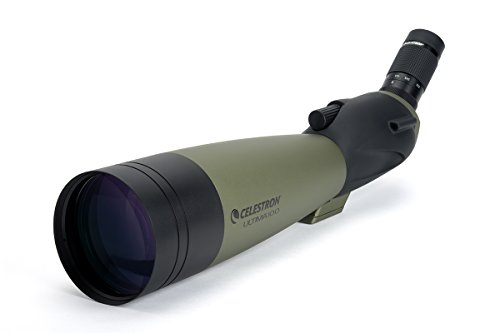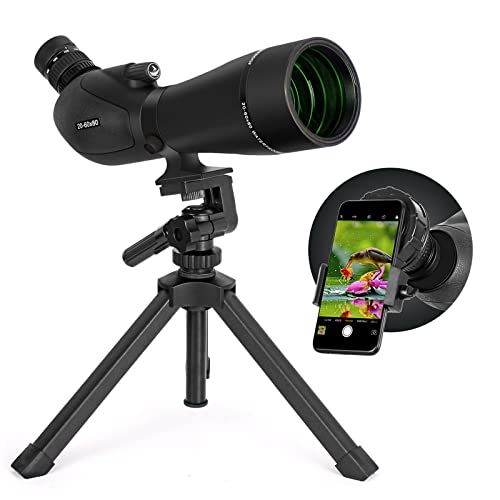Buying Guide for Spotting Scopes
The worst part of traveling is can't enjoy the distance scenes. But, now it is very easy to make your far vision clear. Spotting scopes are popular optical units that provide enlarged images of distant objects, ideal for large-distance viewing and different activities, such as hunting, birding, camping, and surveillance. They are compact high-powered telescopes. They are not spy glasses, even though they are similar in concept. One can use spotting scopes to see what their child is doing, to see which direction their teammates are running, or to determine the direction a star is moving. Photographers and bird watchers also use spotting scopes with cameras for better clarity and detail.
Explore our wide range of spotting scopes to find the best options for you.
Benefits of Spotting Scopes
Superior Magnification
Spotting scopes offer up to 100 times higher magnification than binoculars, which generally offer 8-10 times more. This makes them ideal for viewing objects from greater distances than regular binoculars. When it comes to long distances, then, a spotting scope will offer 10 times more magnification than a pair of binoculars. Shooters use spotting scopes for target shooting. This is especially true for bird watching.
Stability
Spotting scopes often come with tripods due to their weighty lenses. The tripod spotting scope may seem like a disadvantage when you're trying to move around with your equipment, but it actually enhances image quality. Using a spotting scope while hunting calls for a tripod as well. A blurred image from a spotting scope can prevent you from seeing your target if it is shaken.
Larger Objective Lenses
The larger objective lens helps you see better in low light and allows you to use higher quality HD or ED glass, which in turn improves the image quality. Objective lenses on spotting scopes range from 50 to 100 mm, with larger lenses being more expensive. By having larger objective lenses, you are also able to see a larger area because you can see your entire space. This allows you to spot things that you otherwise wouldn't be able to see with a narrow field of view provided by binoculars.
Weatherproof
A spotting scope is a large piece of equipment that can be a big investment. The last thing you want is rain and dust to ruin it. Thankfully, most are built to withstand the elements. They have outer coatings and lens covers that prevent any damage. Weatherproof quality makes spotting scopes for astronomy.
Factors Consider before Buying Spotting Scopes
Requirements
The goal of a spotting scope should be refined before purchasing it. Buyers should decide what the scope will be used for such as bird watching or hunting and where they will be using it such as in a low-light situation. An objective lens with a larger objective diameter can improve low-light performance. A large scope should also be durable and of adequate size, especially if you are selecting a hunting scope. Some scopes, such as those rated 8-35X, can be held like monoculars to improve portability outdoors. Waterproof units with durable armor, on the other hand, are required when hunting, camping, and hiking to resist harsh weather.
Specifications
An important consideration is the magnification level, and the lens diameter. A high magnification level will require a large lens. For example, a 60X-80mm unit (60X is the magnification, and 80mm is the aperture) is considered to be a highly-sufficient scope. It is especially important for glasses wearers to consider eye relief and field of view, since spotting scopes have interchangeable focus lenses.
Total cost
Due to the wide variety of products and companies on the market, prices can range significantly, and high-quality products tend to be more expensive. Materials can also impact prices, and BAK-4 glass prisms are high-quality. Moreover, coatings can affect costs because optics can be coated, fully coated, and multicoated for improved durability. Accessories, from tripods to carry bags, are also essential to ensure the best image quality.
Tripods
The best viewing experience with a spotting scope occurs when it is properly supported. Buy a good tripod according to where and how you will use your scope. For spotting scope with rangefinders, you may need a full-length tripod that lets you stand. For a windswept mountain top, however, a short, sturdy tripod should suffice.
Conclusion
Spotting scopes are an essential tool for outdoor enthusiasts, birdwatchers, hunters, and astronomers. With their high magnification power and superior optical quality, spotting scopes provide crisp and clear images of distant objects. Unlike binoculars, spotting scopes are designed to provide higher magnification, making it easier to spot wildlife and birds from a distance. They are also equipped with features like waterproofing, fog-proofing, and shock resistance, making them ideal for use in harsh weather conditions.
You can find more information on the products we recommend in our featured section above. Our spotting scope reviews and recommendations are based on their quality, accuracy, and durability. After reading hundreds of reviews, we recommend top spotting scopes.

































